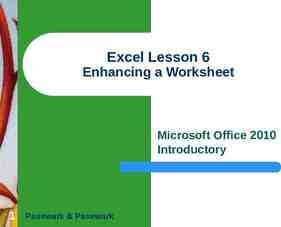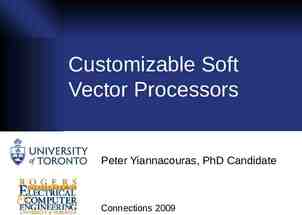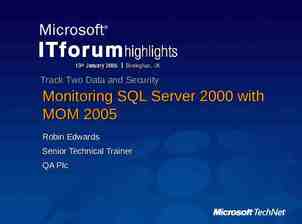Assets (สินทรัพย์) Lectured by Dr. Siriluck Sutthachai
34 Slides162.50 KB

Assets (สินทรัพย์) Lectured by Dr. Siriluck Sutthachai Accounting Department Faculty of Management Science Khon Kaen University Khon Kaen, Thailand

The Nature of Assets There must exist some specific right to future benefits or service potentials. The rights must accrue to a specific individual or firm (control criteria). There must be a legally enforceable claim to the rights or services.

Definition Assets are future economic benefits controlled by the entity as a result of past transactions or other past events. ทรัพยากรที่อยูใ่ นความควบคุมของกิจการ ทรัพยากรดังกล่าวเป็นผลของเหตุการณ์ใน อดีตซึ่งกิจการคาดว่าจะได้รบ ั ประโยชน์เชิง เศรษฐกิจจากทรัพยากรนัน ้ ในอนาคต

Definition Future economic benefits Benefits for a business enterprises are associated with the activities that generate profit. Benefits must assist the entity to pursue its objectives.

Definition Future economic benefits The term ‘Economic’ refers to two characteristics: scarcity and utility. If there is an insufficient supply of a given commodity, and if the commodity has utility so that it is desired or demanded by people, then it has ‘economic’ values.

Definition Future economic benefits An asset is something that exists now, and has the capability of rendering service or benefit currently or in the future.

Definition Controlled by reporting entity Control relates to the capacity of the entity to benefit from the asset in the pursuit of its objectives and to deny or regulate the access of others to that benefit. Must an asset be ‘owned’—that is, must an entity have ‘title’ to the asset—before it can be considered to be an asset of that entity?

Definition Past transactions or other past events This condition is set in order to ensure that contingent assets are excluded. What does the term ‘event’ covers?

Recognition Criteria Reliance on the law Determination of the economic substance of the transaction or event. Use of the conservatism principle: anticipate losses, but not gains. Ability to measure the value of the asset.

Recognition Criteria An asset should be recognised in the statement of financial position when and only when: It is probable that the future economic benefits embodied in the asset will eventuate; and The asset possesses a cost or other value that can be measured reliably. สินทรัพย์ควรรับรูใ้ นงบดุลเมื่อมีความเป็นไปได้ค่อนข้างแน่ที่ ประโยชน์เชิงเศรษฐกิจในอนาคตจะเข้าสูก ่ ิจการ และสินทรัพย์ นัน ้ มีราคาทุนหรือมูลค่าที่สามารถวัดได้อย่างน่าเชื่อถือ

Measurement of Assets The measurement of assets is important because it affects the decisions financial statement users make. Investment decisions Lending decisions Evaluation of management performance

Measurement of Assets Subjective value: management may determine the amount of assets the firm should hold. True economic value: not possible to indicate what the true economic value is. Numerous valuation methods exist, depending on the particular objective driving the need for determining value. Generally, accounting discipline categorises asset measures as either cost or value.

Measurement of Assets Cost refers to ‘opportunity cost’, which is the next best alternative, or opportunity forgone or sacrificed. Cost is the sacrifice incurred in economic activities—that which is given up or forgone to consume, to save, to exchange, to produce.

Measurement of Assets Does ‘cost’ differ from ‘value’? If so, how? Suppose on the day you graduate from university, you ask yourself 2 questions: is the cost of your university education? 1. What is the value of your university education? 2. What

Measurement of Assets Cost represents a sacrifice, while value has to do with future benefits. People, if they are rational, will incur costs when they believe that they will gain something at least equivalent to the costs. Thus, cost approximates value at the time an asset is acquired.

Measurement of Assets The significance of cost, therefore, is that it is indicative of value received at the time of exchange. Over the period of time, if there is evidence that the value is less than cost, or materially greater than cost, an adjustment should be made if accounts are to reflect ‘value’.

Measurement of Assets Cost-based and value-based methods?

Measurement of Assets The cost of acquisition of an asset is the fair value of whatever is given in exchange for the asset plus any costs incidental to the acquisition. Fair value is defined to be the amount for which an asset could be exchanged in an arm-length transaction between a willing buyer and a knowledgeable, willing seller.

Measurement of Assets Present value: The value of an asset is the present value of the future net cash flow related to it. There is a time dimension to the value of money. In order to find the future value, three variables are needed: o o o The future cash amount The discount rate The horizon or length of time.

Measurement of Assets Present value: The present value method results in an estimated value. Whenever the future cash flows are more than conjectures, such as payments for interest and principal for a bond, and the discount rate and horizon are reasonably estimable, the present value method can be and is used in practice for reporting purposes.

Measurement of Assets Market values The market value of a commodity represents the value placed on it by the market. There are certain conditions that affect the market value of an asset: o o Different markets exist. In recognition of the imperfection of the market, time and effort must be spent to find the best price and terms and, depending on one’s success, the final price could vary.

Measurement of Assets Market values Entry Prices: o Replacement cost is the amount that would be paid now to acquire the best asset available to undertake the function of the asset owned. o Current cost is equal to the replacement cost, but adjusted for the value of any operating advantages or disadvantages of the asset owned.

Measurement of Assets Market values Exit price: o Selling price is an exit market price, which could refer to the market for new commodities, or to the secondhand market. o Net realisable value (NRV) is defined as expected selling price less expected costs of disposition

Measurement of Assets Valuation methods—current use Present value: employed for long-term monetary items such as long-term receivables, bonds, and leases. Expected cash: for short-term monetary assets, such as accounts receivable. Historical cost: For nonmonetary assets, such as inventory, land and buildings. Market prices: alternatives to historical costs

สินทรัพย์หมุนเวียน คาดว าจะได รับประโยชน หรือตัง ้ ใจจะขายหรือ ใช ภายในรอบระยะเวลาดําเนินงานตามปกติของกิจการ มีไว เพื่อค า คาดว าจะได รับประโยชน ภายในระยะเวลา 12 เดือน หลังจากวันที่ในงบดุล หรือ เป นเงินสดหรือรายการเทียบเท าเงินสด (ตามที่ได้ นิยามไว้ในมาตรฐานการบัญชีฉบับที่ 25 (ปรับปรุง 254X) เรื่อง งบกระแสเงินสด) และไม มีข อจํากัดใน การใช อย างน อยภายในระยะเวลา 12 เดือนนับจาก วันที่ในงบดุล

สินทรัพย์หมุนเวียน เงินสดและรายการเทียบเท่าเงินสด เงินสด หมายถึง เงินสดในมือ เงินฝากธนาคาร เช็คที่ยง ั ไม่ได้นำฝาก ดร๊าฟธนาคาร เช็คเดินทาง และธนาณัติ รายการเทียบเท่าเงินสด คือ เงินลงทุนระยะสัน ้ ที่มี สภาพคล่องสูง และพร้อมจะเปลี่ยนเป็นเงินสดใน มูลค่าที่เท่ากันหรือใกล้เคียงกับมูลค่าเดิม

สินทรัพย์หมุนเวียน เงินลงทุนชัว่ คราว เงินฝากธนาคารประเภทประจำ หรือหลักทรัพย์ที่ซ้ อ ื จากเงินสดของกิจการเพื่อให้ได้รบ ั ประโยชน์จากการ ลงทุนนัน ้ เงินลงทุนที่กิจการตัง ้ ใจถือไว้ไม่เกินหนึ่งปี ประเภทเงินลงทุนชัว่ คราว หลักทรัพย์เพื่อค้า หลักทรัพย์เผื่อขาย เงินลงทุนทัว ่ ๆไป ตราสารหนี้ที่ครบกำหนดระยะ 1 ปี

สินทรัพย์หมุนเวียน ตั๋วเงินรับ คำมัน ่ สัญญาที่เป็นลายลักษณ์อักษรโดยปราศจาก เงื่อนไข ที่บุคคลหนึ่งรับชำระเงินจำนวนหนึ่งที่ แน่นอนให้แก่อีกบุคคลหนึ่งภายในเวลาที่กำหนด ประเภทของตั๋วเงินรับ ตัว๋ สัญญาใช้เงิน ตัว๋ แลกเงิน

สินทรัพย์หมุนเวียน ลูกหนี้ สิทธิเรียกร้องที่กิจการมีต่อบุคคลอื่นในการที่จะได้ รับชำระหนี้ในรูปเงินสด, สินทรัพย์อ่ ืน หรือบริการ ประเภทของลูกหนี้ ลูกหนี้การค้า—ลูกหนี้ที่เกิดจากการดำเนินการค้า ปกติของกิจการที่เกิดขึ้นจากการขายเชื่อ ลูกหนี้อ่ ืนๆ—ลูกหนี้ที่ไม่ได้เกิดจากการค้าปกติของ กิจการ

สินทรัพย์หมุนเวียน สินค้าคงเหลือ การนำเสนอมาตรฐานการบัญชีฉบับที่ 31 สินค้าคงเหลือ ราคาทุนของสินค้าคงเหลือ หมายถึง จำนวนรวมของ ต้นทุนในการซื้อ ต้นทุนในการแปรสภาพและต้นทุนอื่นๆ ที่ เกิดขึ้นเพื่อทำให้สน ิ ค้าคงเหลือนัน ้ อยูใ่ นสภาพและใน สถานที่ที่พร้อมที่จะขายได้ ต้นทุนในการซื้อได้แก่ ราคาซื้อของสินค้ารวมทัง ้ ค่าภาษีขาเข้าและภาษีอ่ ืนๆ ที่ เกี่ยวข้องโดยตรงกับการซื้อนัน ้ ค่าขนส่งค่าขนถ่ายสินค้า ค่าใช้จา่ ยอื่นๆ ที่เกี่ยวข้องโดยตรงกับการซื้อ ส่วนลดการค้า (หัก) เงินที่ได้รบ ั คืน และเงินชดเชยอื่นๆ (หัก)

สินทรัพย์หมุนเวียน รายการที่ควรรวมเป็นสินค้าคงเหลือ? สินค้าระหว่างทาง (Goods in transit) สินค้าที่แยกไว้ต่างหาก (Segregated goods) สินค้าฝากขาย (Goods on consignment) สินค้าที่ขายโดยมีเงื่อนไขและสินค้าที่ขายตามสัญญา ผ่อนชำระ (Conditional and installment sales)

สินทรัพย์หมุนเวียน สินค้าคงเหลือ สินค้าคงเหลือแสดงในราคาทุนหรือมูลค่าสุทธิที่ จะได้รบ ั แล้วแต่อย่างใดจะต่ำกว่า มูลค่าสุทธิที่จะได้รบ ั หมายถึง ราคาที่คาดว่าจะขาย ได้ตามปกติของธุรกิจ หักด้วยต้นทุนส่วนเพิม ่ ที่จะ ผลิตให้เสร็จ (สำหรับสินค้าที่อยูร่ ะหว่างการผลิต) และค่าใช้จา่ ยอื่นๆ ที่จำเป็นต้องจ่ายเพื่อให้ขาย สินค้านัน ้ ได้

สินค้าคงเหลือ การตีราคาสินค้าคงเหลือ การเปรียบเทียบราคาทุนกับมูลค่าสุทธิที่จะได้รบ ั เปรียบเทียบราคาของสินค้าแต่ละรายการ เปรียบเทียบราคาสินค้าแต่ละจำพวก เปรียบเทียบราคาสินค้าเป็นยอดรวม

ตัวอย่าง สินค้ ราคา า ทุน ราคาที่ ต้นทุนทำต่อ มูลค่าสุทธิ คาดว่า จนเสร็จและ ที่จะได้รบ ั จะขายได้ จำหน่าย ราคาทุน หรือมูลค่า สุทธิที่จะ ได้รบ ั ที่ต่ำ กว่า A1 A2 600 200 650 215 70 10 580 205 580 200 A3 B1 400 500 428 580 23 70 405 510 400 500 B2 C1 900 450 925 475 15 40 910 435 900 435






